Chloé Perdrix writes: Medicine in the Jungle in Malaysia.
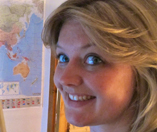 My name is Chloé Perdrix, I’m a 27 year old French GP resident, just ending my last rotation in a health centre in the North-East of New Caledonia. After this last rotation in New Caledonia, I intend to take a sabbatical year travelling around Asia. In order to stay in touch with the medical network, I intend to meet general practitioners during this journey. I proposed to WONCA and the Vasco da Gama Movement (VdGM), to write an article each two months in order to share my discoveries, my questions and my reflections about this experience. This is my second story.. to see others click here.
My name is Chloé Perdrix, I’m a 27 year old French GP resident, just ending my last rotation in a health centre in the North-East of New Caledonia. After this last rotation in New Caledonia, I intend to take a sabbatical year travelling around Asia. In order to stay in touch with the medical network, I intend to meet general practitioners during this journey. I proposed to WONCA and the Vasco da Gama Movement (VdGM), to write an article each two months in order to share my discoveries, my questions and my reflections about this experience. This is my second story.. to see others click here.
Here I am in Malaysia.
Final reflections on New Caledonia
The New Caledonia experience is now finished with the balance sheet of this rotation abroad being :
- interesting diagnoses : four cases of syphilis (one secondary and three primary); two hepatic amoebiasis cases; a perforated ulcer; lung cancer, whooping cough; and of course common diagnoses like influenza, gout, boils…(fortunately no Ebola)
- Palliative care, chronic diseases such as diabetes, obesity, hypertension, asthma, COPD, child medicals eg school visits with a large amount of obesity screening (as obesity is exploding in New Caledonia) , home visits...
- A humane and competent medical team, even if it changed a lot during these six months.
- Wonderful persons I met: specially one from Kone who will recognise himself and two patients who became friends and from whom I learnt a lot about kanak culture,
- A personal and work experience which will contribute top my personal and professional lives.
- And last but not least, I feel ready to be a family doctor.
My final reflection about New Caledonian’s health system, is about the short turnaround in medical staff. This is a big problem for patients because when they trust in a medical staff member, this person often leaves after several months.
Indeed, the majority of medical staff is from France, since New Caledonia don’t have a medical university. Medical staff often come to Pouebo for a new experience but rarely to stay there.
Furthermore, if a local person from New Caledonia wants to do medical studies, they have to go to France or Australia/New Zealand (if they speak english) which is complicated.
Fortunately, for a few years now, they have a nursing school, but for the moment, most of young nurses prefer staying in urban places like Nouméa, the capital.
It is a real problem for doctor-patient relationship and primary care compliance.
Next country: Malaysia
Now is the next chapter of the trip : sharing primary care experiences in Asia through articles in WONCA’s news and thanks to mini Family Medicine 360 exchanges during the coming year.
The Family Medicine 360° Program is a global exchange program for medical doctors training in General Practice and junior General Practitioners (within five years of completing residency training) organised by Vasco da Gamma Movement (VdGM). The VdGM is the WONCA Europe movement for new and future General Practitioners.
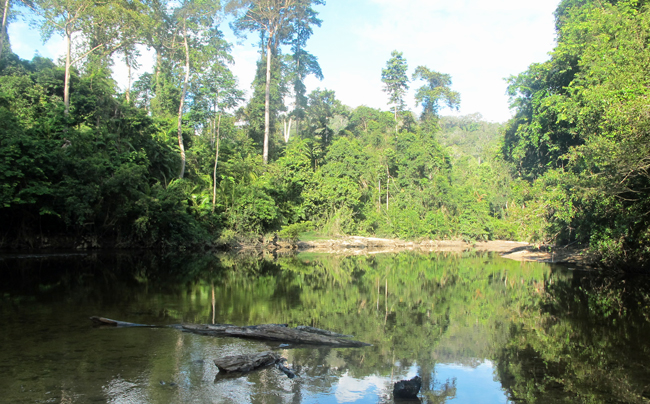 I didn’t have time to organize a mini FM360 exchange as I have only been in Malaysia for 15 days, but I already have lot of things to share with you.
I didn’t have time to organize a mini FM360 exchange as I have only been in Malaysia for 15 days, but I already have lot of things to share with you.
I joined my brother in Kuala Lumpur, on the 4th of November. We quickly decided to do a four day trek in the oldest jungle of the world: Taman Negara (130 million years). It is situated in the centre of the east coast of Malaysia.
Photo: the Taman Negara
There, we spent a day and a night in an Orang Asli village (pictured). The Orang Asli are native people who live in the rain forest. They have their own concept of health and illness [2] and they use mostly traditional medicine. For instance, they send sick people into the jungle with one other person who will take care of them until they recover. I suppose that this tradition is to avoid epidemics, but that’s just a hypothesis.
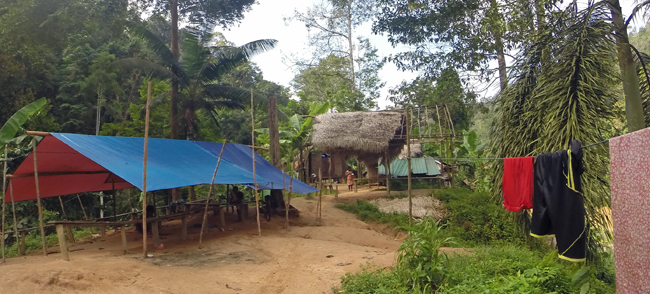 Another tradition : when people die, the Orang Asli don't bury them. They put them in a hole in a tree, in the jungle to help them in leaving the world.
Another tradition : when people die, the Orang Asli don't bury them. They put them in a hole in a tree, in the jungle to help them in leaving the world.
Medicinal plants are used for various medical problems : from flu, to cancer.
They are the object of lot of scientific research. [1], [3], [4] The plant for leech bites is interesting. (A leech is a very small animal which has hundreds of teeth leeches are very numerous in the jungle.)
When a leech bites someone, it attaches to them for a period and secretes anticoagulants which make its victim bleed a lot, even after the leech has dropped off them. It's not painful, and not dangerous, but it is very annoying because you bleed on your pants, socks and shoes. [5]
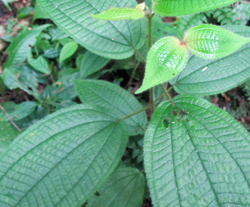 To avoid that, the Orang Asli people use a special plant (pictured) that you wet, then rub energetically between hands. A paste appears after 20-30 seconds. If you apply this paste on the leech bite, the bleeding stops. I used it a lot of times during these four days. It was very effective.
To avoid that, the Orang Asli people use a special plant (pictured) that you wet, then rub energetically between hands. A paste appears after 20-30 seconds. If you apply this paste on the leech bite, the bleeding stops. I used it a lot of times during these four days. It was very effective.
A lot of questions about the Orang Asli people stay without responses, since I only spent 24 hours in their village. How is the children’s health? Women’s health? I didn't see any old people – where were they?
It seems that the Orang Asli people’s health is not so good : they’ve got more tuberculosis than the state average; leprosy; skin infections such as scabies; and nutritional deficits, especially for women and children. [2]
This experience was very interesting, even if it was very short, and I didn’t have the opportunity to discuss more about the Orang Asli medical customs.
To complete my investigation, I decided to visit a health centre in Kuala Tahan, the village next to the entrance to the Taman Negara.
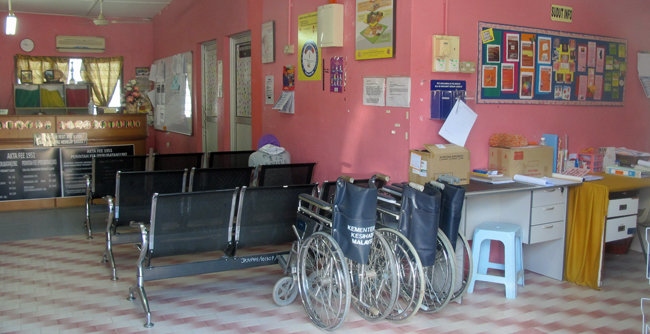 This is a more classic public health centre (pictured) as we see in Europe. Malaysian people pay 1 Ringgit MYR (= 0,238 EUR = 0,298 USD) for a consultation and their medicines. Foreigners pay 5O MYR (12euros, USD15). The nearest hospital is 1 hour by car from the Health centre (Jerantut).
This is a more classic public health centre (pictured) as we see in Europe. Malaysian people pay 1 Ringgit MYR (= 0,238 EUR = 0,298 USD) for a consultation and their medicines. Foreigners pay 5O MYR (12euros, USD15). The nearest hospital is 1 hour by car from the Health centre (Jerantut).
They have one General practitioner who sees all emergencies; nurses, midwives, and paramedicals or medical assistants called “Assistant Medical Officers” that don’t exist in France: who are they?
In fact, they work independently or with the limited supervision of a physician to provide healthcare services. They diagnose and treat common ailments, order and interpret tests, counsel on preventive health care, assist in surgery, manage medical/surgical emergencies, manage medical/surgical wards, manage obstetrics & gynaecology, and write prescriptions. They often work in places with no medical officers.
Assistant Medical Officers complete a three and half year Diploma in Medical Assistant (DMA) – an undergraduate program recognised by the Malaysian Qualification Agency.
The students study the human body, how the body systems work, surgery, pharmacology. They work in normal and diseased states and how they relate to medicine. They also learn pre-hospital care, community health, disaster management, orthopaedics, obstetrics and gynaecology. The final year of training involves clinical placement in hospitals and health centres.
So this is what I learnt about primary care in one part of rural Malaysia during these first 15 days.
I hope this story meets your expectations! See You in January for another Asian destination !
Chloé
Bibliography :
1. Samuel AJSJ, Kalusalingam A, Chellappan DK, Gopinath R, Radhamani S, Husain HA, et al. Ethnomedical survey of plants used by the Orang Asli in Kampung Bawong, Perak, West Malaysia. J Ethnobiol Ethnomed. 7 févr 2010;6:5.
2. Nicholas C, Baer A. Health Care For The Orang Asli: Consequences of Paternalism and Colonialism [Internet]. Center for orang Asli Concerns. 2012 [cité 19 nov 2014]. Disponible sur: http://www.coac.org.my/beta/main.php?section=articles&article_id=13
3. Ong HC, Faezah AW, Milow P. Medicinal Plants Used By the Jah Hut Orang Asli at Kampung Pos Penderas, Pahang, Malaysia. Ethno Med. 2012;1:11 5.
4. Orang Asli ( indigenous Malaysian) biomedical bibliography
5. Traditional Knowledge of Orang Asli on forest in peninsular Malaysia
6. http://www.hirudolab.com/leech.html